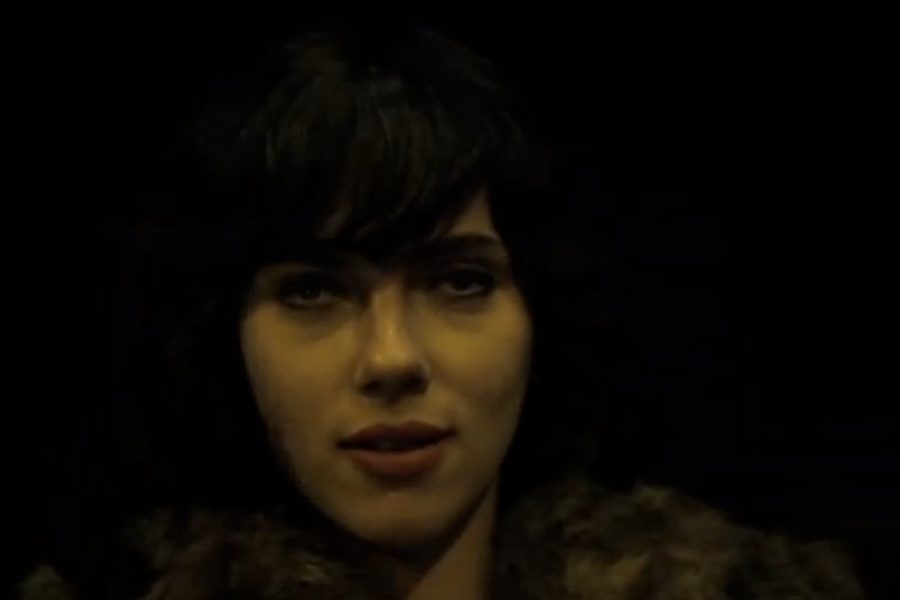Under the Skin’s Weird Feminism
Surprisingly, Scarlett Johansson’s alien succubus has a lot to tell us about what it’s like to be a woman.
Jude Ellison Sady Doyle

Jonathan Glazer’s new film Under the Skin is one of the most profoundly weird feminist statements you’ll ever see. In conventional summer-movie terms, this thing has almost nothing going for it: There’s almost no dialogue. The cast is largely unknown, and often amateur. Chunks of the movie were shot using the “disguised actor engages with unwitting civilians” method perfected in such masterpieces as Bad Grandpa and Borat. The plot ranges from “obscure” to “impenetrable.” (I watched it pretty closely, and had been prepped fairly well beforehand, and I had no idea why the story kept cutting away to an ominous guy on a motorcycle until I read the film’s Wikipedia page.) None of the characters has a name. We are asked to root for a protagonist who kills a baby. There’s a downer ending. Just about the only thing Under the Skin has in common with the current #1 movie at the box office—Captain America: The Winter Soldier—is the presence of Scarlett Johansson. And the only traditional selling point, when it comes to choosing the former over the latter, is that in this one, Scarlett Johansson gets naked.
Of course, the first time we see Scarlett naked, she’s stripping down the corpse of one of her victims, so that she can wear its clothes. Also, she’s doing so in a glowing, white, featureless void that may or may not be meant to represent an alien spacecraft. Also, and despite the plentiful presence of Full Frontal Scarlett, we actually get far more of nude men and their exposed penises — in terms of both quantity and screen time — than we ever do of naked breasts.
So, you know. It’s not a popcorn movie. But it is one of the most beautiful things you’ll ever see in a theater: That impenetrable plot moves at a stately pace, guided by a camera that can find terror and beauty in the sight of trees blowing in the breeze, fog and sea-spray spiraling off the coast, or a floating corpse. It’s also got a plot that should please any given gender-studies major: It’s a movie about an alien (that would be Johansson) who learns to be a human woman, and profoundly regrets the lesson. And, before she’s fully internalized that role, she has a bad habit of seducing and destroying men.
It’s hard to summarize the plot of Under the Skin without either giving too much away or forcing a definite interpretation on what is purposefully oblique and ambiguous. (Although the movie is, technically, an adaptation of a novel — by Michael Faber, who also did some fabulously smart things with gender in his bestseller The Crimson Petal and the White—it deviates wildly from the plot contained therein.) But here’s one attempt: Scarlett lands on our planet, does the aforementioned corpse-stripping, and sets out in her van to harvest the men of Scotland. She goes about this process with the frank efficiency of a predator in the wild; she can mimic a human being just well enough to pull over her van, ask for directions, and assess and capture her prey. If they have friends or family nearby, she takes their directions and moves on; if they’re unattached, she offers them a ride and, eventually, sex in her apartment. (The “hidden camera” is used in these scenes, to capture the lascivious and/or baffled reactions of actual Scottish men trying to cope with the fact that they’ve been picked up on the street by a brunette, inexplicably British-sounding Scarlett Johansson.) Her “apartment,” as it turns out, is an infinite black void, which none of these men seem to notice or even really mind. Once there, she slowly walks away from them, they strip and follow her, and the floor turns into black goo and swallows them whole. (These men, given the indignities they’re subjected to, were presumably actors. Unless someone committed to six weeks of green-screen work in the nude just to see Scarlett Johansson take half her shirt off, which … well, come to think of it, that also seems possible.) What happens to the men afterward, I think, is something the viewer should be allowed to discover on his or her own.
Johansson, in these scenes, is the Anti-Feminine: fully in control, wholly unemotional, entirely disconnected from other human beings, and utterly terrifying. After one murder on an isolated beach, she leaves a victim’s baby to be drowned by the rising tide, not out of malice, but because she seemingly doesn’t understand what a baby is or why it matters. When she’s confronted with other women — a group of them hustle her into a club — she shows the same blank incomprehension. She only utilizes human facial expressions or language while she’s chatting up potential victims, and even there, she seems to be stuck using a few useful phrases — “do you have a girlfriend,” “you’re very handsome,” “do you think I’m pretty,” etc. — like a tourist who’s learned them from a guidebook.
It’s clear that the movie wants to say something about gender, even this early on. Just look at those seduction scenes: Johansson talks, the men answer her. Johansson leads, the men follow. The men strip — and are subjected to some very objectifying full-frontal shots — and Johansson keeps her clothes on.
But the real action of the movie, and the truly smart commentary, picks up where all the man-drowning leaves off. One of Johansson’s potential victims, a disabled man, sets something off in her — empathy, pity, or simply common feeling for someone who seems as isolated and ill-at-ease in his body as she is — and she lets him go. Enter Ominous Man With Motorcycle — her alien handler, as per the Internet — and his attempts to track her down. Scarlett abandons her apartment of doom and goes on the run, eventually shacking up with a relatively kindly gentleman. It’s at this point that she becomes an entirely different creature, less predatory Alien than stranded E.T. Her bafflement as she attempts to eat human food, or watch television, isn’t cute, precisely. She stays chilly and off-puttingly blank throughout. But it’s hard not to sympathize with her newfound powerlessness and her total incomprehension of the world around her. In this half of the movie, everything shifts, and reverses itself: Men talk, and Johansson stays quiet. Men lead, and Johansson follows them. Johansson gets an objectifying full-frontal shot, and the men keep their clothes on. And, yes, eventually, she learns that there is more than one way to be a predator, and more than one way to become prey.
There’s a lot to praise in Under the Skin: It is just unspeakably beautiful, and deeply scary, and it often manages to be both at the same time. It’s profoundly original and daring. It’s the rare sci-fi film about aliens that forsakes cool spacecraft and explosions, and gives us something that truly feels alien, wholly other than human and quite possibly beyond human understanding. And, most importantly, it manages to put us in the shoes of that Other: By giving us a movie that doesn’t work like any other movie, it forces us to see the world through the eyes of something that doesn’t think like humans think. That it actually manages to create sympathy for that creature, after we’ve seen it do several unspeakably gory and baby-endangering things, is nothing short of miraculous.
But, then: There’s another segment of the population that we’re taught to see as Other, to dis-identify with, and those people often do quite a lot of talking about how they feel they’ve been stuck on a planet that’s not made with them in mind. Under the Skin doesn’t just try to make us see the world through the eyes of a human-devouring, baby-drowning alien invader. It tries to make us understand what it feels like to be a girl.
Jude Ellison Sady Doyle is an In These Times contributing writer. They are the author of Trainwreck: The Women We Love to Hate, Mock, and Fear… and Why (Melville House, 2016) and was the founder of the blog Tiger Beatdown. You can follow them on Twitter at @sadydoyle.








